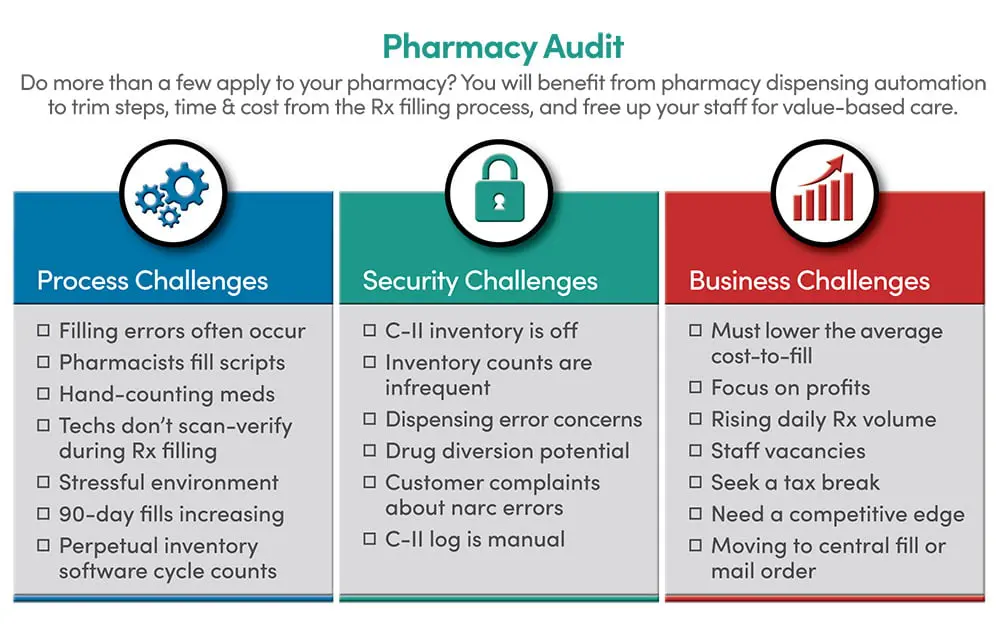Retail pharmacists are essential and highly accessible healthcare providers. They are the trusted experts who dispense prescriptions and suggest over-the-counter remedies for common illnesses or chronic conditions. But a community pharmacist’s abilities go much further today. A staggering 97% of Americans believe a pharmacist is responsible for informing patients about medication safety and effectiveness. This highlights the evolving role of the pharmacist beyond prescription dispensing to broader patient care, which was especially evident in light of the COVID-19 pandemic.
Reports revealed heightened demands and pharmacy staff shortages that overburdened pharmacy managers. Consequently, about 51% of Americans expressed concern about potential problems with their prescriptions. In response to these opportunities and challenges, pharmacy automation is becoming the enabler of a brighter future for community pharmacies.
Recent data shows that 48% of pharmacists and 66% of prescribers effectively leveraged pharmacy automation to align with their growing role in patient care. The readiness of retail pharmacies to explore automation can empower pharmacists to deliver more comprehensive, personalized services to patients. Technology integration can further enhance pharmacy efficiency and ensure that healthcare is accessible globally.
A retail pharmacy seeking comprehensive transformation can begin by identifying and eliminating manual, time-consuming processes that affect efficiency, put patients at risk, or impede value-based care initiatives. The pharmacy can customize automation systems to align with its needs and resources.

You can evaluate the automation readiness of your retail pharmacy by assessing current processes, staff capabilities, known risks, business growth initiatives, and technological infrastructure.

Analyzing your current workflow and identifying bottlenecks – especially delays that cost extra steps, time and labor – is crucial for optimizing your pharmacy’s efficiency. Begin by mapping out each step in the medication dispensing process. Identify areas where delays or inefficiencies occur, such as manual data entry, hand-counting, will-call bin searching, or pharmacists correcting mistakes such as the wrong strength or quantity of an order.
Once you identify the bottlenecks, consider automation solutions that alleviate these challenges. It can enhance overall performance to provide more streamlined and timely pharmacy services.
The Importance of a Pharmacy Automation Checklist
A pharmacy automation checklist is a valuable tool for assessing gaps. Consider the following ways to organize and prioritize your most pressing problems or opportunities for growth:
If your pharmacy faces these issues, tailored automation can help save time, reduce costs, and reassign staff for higher-value tasks and patient care. Identifying such challenges can help you explore specific automation solutions to streamline processes.
In pursuit of operational excellence and expert care, identify repetitive tasks suitable for automation. Plus, look at the talents and interests of your team members. Then, redistribute and assess again. Here are some tips to guide the process:
By systematically addressing these challenges, your pharmacy can determine the repetitive tasks best suited for automation, empowering your team to focus on higher-value initiatives and primary care.

Installing automation will change some workflows, even for the simplest technologies. Involve your team members in decision-making to ensure a smooth transition. Communicate clearly to help them understand the benefits of pharmacy automation. If needed, demonstrate the positive impact of automation on efficiency, competitive advantages, and patient care. Provide comprehensive training and continuous support. Also, encourage staff to suggest process improvements to empower them.
A phased implementation can help you gradually introduce automation and ease the adjustment process. Assess the impact of automation at each stage and adjust strategies as needed. These strategies foster staff acceptance and ensure the successful integration of pharmacy automation.
Conduct a thorough cost analysis and return on investment (ROI) assessment to evaluate your pharmacy automation readiness. Assess initial and ongoing expenses, labor savings, inventory control improvements, and patient outcomes. Also, consider the competitive edge it may provide. Recognize its role in risk mitigation, scalability, and non-monetary benefits such as pharmacy morale, stress reduction, and patient satisfaction. A comprehensive cost analysis will help you make an informed decision about pharmacy automation, weighing its financial and operational advantages.

Pharmacy automation traces back to the 1960s. It began with new digital pill-counting machines to replace the labor-intensive practice of manually counting pills using a plastic tray and spatula. The technology helped save significant time and reduce the risk of errors.
Since then, pharmacy automation evolved into a realm that extends beyond robotic drug dispensing systems. Current technology uses various systems that streamline processes and make them repeatable for employees with any skill level, enhance predictability, provide metrics and records for past activities, and reduce the manual workload of pharmacy staff for improved efficiency and patient-centric service.
At its core, pharmacy automation seeks to eliminate manual, repetitive tasks and streamline operations. It leverages technology to optimize inventory levels, ensuring that prescription medications are always available without a large stockpile sitting on the shelves. It also includes state-of-the-art robotic systems designed to reduce human intervention in dispensing and packaging medications. Pharmacies can integrate various automated modules with existing pharmacy management systems for valuable insights to improve operational efficiency. Whether automation takes the form of a small device or an overarching software program, the outcome is usually the same: Improvement in the pharmacy’s operation, staff satisfaction, and patient care.
If your retail pharmacy is ready for automation, learn more about operational enhancement and explore the transformative potential offered by Capsa Healthcare’s innovative pharmacy automation solutions. Discover how our pharmacy automation technology can help you move toward a more efficient, profitable, and error-free future as a complete healthcare and wellness destination in your community.